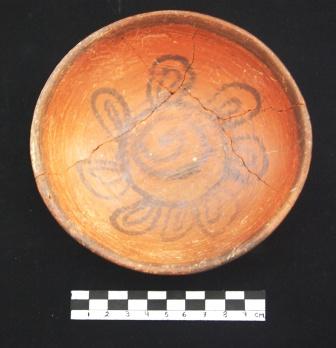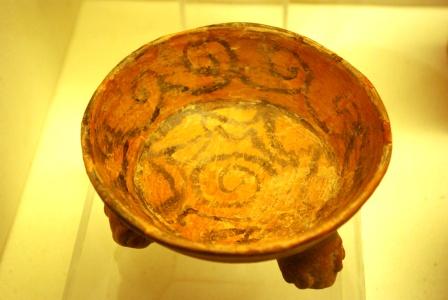Cocoyotla Black on Natural
Cocoyotla Black on Natural is characterized by black painted decoration over the natural orange color of the paste. Some subtypes include painted decoration over a matte white background.
Paste and Firing Effects
The paste is light brown to light reddish-brown in color. It has fine to medium consistency, and is fired to a medium hardness that often results in irregularly jagged breaks. Dark gray firing cores occasionally occur.
Surface Treatment
The surface is usually unslipped, but is lightly to medium burnished. The surface color is usually light brown to light reddish- brown. In the Banded subtypes, an orange slip very close to the natural color of the paste was applied over a thin white base coat. Although this diverges from the concept of a "natural" surface finish, similarities in color, decorative themes, and vessel forms are the rationale for interpreting subtype variation.
Decoration
Decoration in the basic Sencillo subtype is in the form of black painted lines forming simple to complex patterns (Figs. 1 and 2). A distinctive characteristic is the blurred appearance of the painted lines, as if the paint was smeared while still wet. The most common patterns are a series of concentric horizontal or wavy lines around the interior rim. More complex patterns include geometric and naturalistic floral and zoomorphic figures on the interior base.

Figure 1: Cocoyotla Black on Natural subhemispherical bowl

Figure 2: Cocoyotla Black on Natural tripod conical bowl
In addition to the basic Sencillo subtype, four other subtypes were recognized at UA-1: Incised, Banded, Banded Elegante, and Chalco Black on Orange.
The Incised subtype has a black painted panel on the exterior, extending down 1 to 3 cm below the lip, with thinly incised decoration within the panel (Fig. 3). Decorative motifs include curvilinear and geometric patterns, some of which are codex-style designs.
The Banded subtype is identified by 2 to 4 horizontal bands painted below the interior rim on an orange slip similar in color to the natural color of the paste (Figs. 4). A characteristic of this subtype is a matte white panel on the exterior rim extending 2 to 4 cm down from the lip, sometimes with additional horizontal bands painted in black. Matte white paint can also appear on the interior base, decorated with 2 to 4 concentric circles. Careful inspection indicates that the matte white is a base coat, over which the orange slip was applied.

Figure 4: Cocoyotla Banded subhemispherical bowls
The Banded Elegante subtype is similar to the previous subtype, particularly in reference to the use of "natural"-colored orange slip over a white base and horizontal bands on the interior rim. Banded Elegante, however, has more elaborate painted decoration on the matte white panel of the exterior rim, with motifs including "earth monster" motifs and other glyphic themes (Fig. 5). In some examples patterns outlined with black lines are filled with orange color identical to the slip color.

Figure 5: Cocoyotla Black on Natural Elegante superhemispherical bowl

Figure 6: Cocoyotla Black on Natural Elegante tripod hemispherical bowl
Chalco Black on Orange subtype is similar to the basic Sencillo subtype in its use of black paint over the natural surface, but is distinctive in terms of design configuration and surface treatment. The painted decoration is a horizontal panel delineated by straight and/or wavy lines usually around the interior rim (Fig. 6). The panel is filled with geometric patterns often in the same style of blurry lines as in the basic Sencillo subtype. The surface is medium burnished to a dull luster. The most common vessel form is a conical bowl, but with a slightly everted lip.
Additional subtypes identified at the Patio of the Carved Skulls included Cocoyotla Natural (lacking any black paint), Black Rim, and White on Natural. Since these were not identified at UA-1 they are not included in the tabulations.
Vessel Forms
Cocoyotla Black on Natural appears as serving vessels, with the two most common forms being subhemispherical bowls and conical bowls. Subhemispherical bowls occur in nearly all subtypes (except Incised). Subtype Sencillo subhemispherical bowls measure 15 to 17 cm in diameter, and about 3 to 4 cm in vessel height. Subtype Banded subhemispherical bowl are generally larger, measuring 14 to 24 cm in diameter, and 4 to 6 cm in vessel height. Conical bowls occur in every subtype, but are most common in the Banded subtype, where they measure about 16 to 20 cm in diameter.
Discussion
Cocoyotla Black on Natural has previously been identified by Noguera (1954:99-110) as decoración negra sobre el fondo color natural del barro. It has been compared to Early Aztec (Group I or Aztec I) Black on Orange pottery from the Valley of Mexico (Noguera 1954:282). Another source of comparison is with the Gulf Coast, where the type is similar in decoration, surface finish, and vessel form to X-Fine Orange (R. Smith 1958).
Noguera recovered this type in the earliest Postclassic levels, and it was the predominant decorated type found at the Altar of the Carved Skulls (Noguera 1937; 1954:100-101, 225-6, 282-3). For this reason Noguera considered it a valuable diagnostic for identifying the Cholulteca I period. Müller (1978:101-105) identified several "types" of black on natural based on vessel form, and used them as diagnostics for her Cholulteca II phase.
Mountjoy and Peterson (1973:31, Table 1) classified this as "Minutti Black on Orange." It appeared as only a trace (.7%, n=32) in the dated midden excavated at the Faculty Housing Complex (Mountjoy and Peterson 1973:33). At the UA-79 excavations, "Cocoyotla Black on Orange" was again found as only a trace (.3%, n=11) in the F-10 midden (Barrientos 1980). Cocoyotla Black on Natural pottery from a well in San Pedro Cholula occurred in association with other Early Postclassic types such as Ocotlán Red Rim (McCafferty 1996a).
In the UA-1 assemblages, Cocoyotla Black on Natural appeared in low frequencies in the Trash Midden and Well 3 assemblages, 7% and 8% respectively (Table 12). It should be noted that the most common subtype was Cocoyotla Banded, which is probably a later variation of the Cocoyotla type. From the floor contact deposits of Structure 1, Cocoyotla made up 12% of the assemblage, with a higher proportion of the Sencillo subtype, while at Structure 2 it appeared as 4% of the floor contact deposit. A complete Cocoyotla subtype Sencillo bowl (UA-1 #10147) was found in association with Individual #4 in an intrusive burial pit through the floor of Structure 1.
When additional testing was conducted at the Patio of the Carved Skulls (McCafferty and Suárez C. 1995), Cocoyotla made up about 30% of the assemblage (McCafferty 1996a). Previously unrecognized subtypes such as Cocoyotla Natural and Black Rim were significant elements of the assemblage, while the Banded, Banded Elegante, and Chalco subtypes were not present. Since this is interpreted as an Early Tlachihualtepetl context it reinforces the suggestion that Cocoyotla Black on Natural subtypes can be used to identify temporal change in Epiclassic and Early Postclassic Cholula.
The Chalco Black on Orange subtype holds additional potential for building a relative chronology linking Cholula with the Valley of Mexico. The attributes of vessel form, design configuration, and especially the slightly everted lip are similar to "Early Aztec Black on Orange" described by Parsons and Parsons (1982), especially examples found at Operation B of Ch-Az-195. Four C14 samples from this excavation resulted in a consistent cluster of dates between about 650-850 c.e. (Parsons et al. 1982:19, Table 5). A recent series of dates from Xaltocan support an early date (700-1000 c.e.) for "Early Aztec" period Black on Orange pottery (Brumfiel 1992). Further reevaluation of the role of Black on Orange ceramics in Epiclassic and Early Postclassic sequence is ongoing (Parsons, Brumfiel, and Hodge 1996).
Spatial analysis of "Black on Orange" pottery from the southern Valley of Mexico has resulted in a refinement of type distinctions (Hodge and Minc 1990, 1991). Based on this classification, Chalco Black on Natural from UA-1 corresponds closely with the "Mixquic" variety of "Early Aztec" Black on Orange.
Although a detailed ceramic classification is not available from Cerro Zapotecas, "thin line red design" ceramics appear to have similar attributes of design and possibly lip form (Mountjoy 1987:142, fig. 4i-j). The site is dated between A.D. 600-800 (Mountjoy 1987; Wolfman 1990), consistent with the C14 dates collected by Parsons and Brumfiel.
In summary, Cocoyotla Black on Natural is an important type for correlating the Cholula ceramic sequence with the Valley of Mexico. It provides a basis for interpreting cultural contacts linking Epiclassic and Early Postclassic Cholula with the Valley of Mexico and the Gulf Coast. Additionally, possible diachronic variation between the different subtypes of Cocoyotla may provide a means for further refinement of the ceramic sequence.

